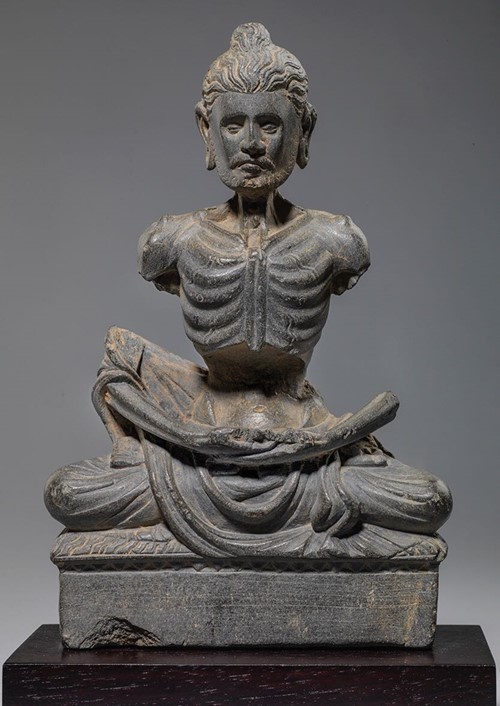
Gandhara, 2nd/3rd century
EMACIATED BUDDHA
A small carved grey schist sculpture of the emaciated Buddha, seated in dhyanasana on a grass covered plain pedestal.
The Buddha stares directly out at the viewer, his deep-set eyes creating a haunting and almost hypnotic quality. Above, his matted, wavy hair is tied to the top in a usnisha. His gaunt, skeletal face has a pursed narrow mouth and wispy beard. Below, his torso shows the web of tendons around the neck and also his ribcage. His flesh has almost entirely disappeared, leaving only skin and sinews tightly stretched around the skeleton, indicating the extreme situation between life and death. This realism can be traced back to the earlier Hellenistic style which obviously greatly influenced Gandharan sculpture.
His bony shoulders to either side barely support his sanghati or triple robe, traces of which can be seen draped in pleats over his crossed legs covering all but the toes of his feet. The detailed depiction of how an emaciated torso would look suggests a knowledge of anatomy from the sculptor, which contributes to the power of the image. The spine, visable through the sunken abdomen is a feature which is also described in Buddhist texts.(1)
Representations of the Fasting Buddha such as seen here are rare in Gandharan art.(2) The small size also suggests that it would have been part of a portable shrine for worship at home or from a larger panel of jatakas or stories from the Buddha’s life. For similar emaciated Buddhas also formerly from the Samuel Eilenberg Collection, see Martin Lerner and Steven Kossak, The Lotus Transcendent, 1991, pp. 84-85. A much larger emaciated Buddha in the same pose can be seen in Isao Kurita, Gandharan Art 1: The Buddha’s Life Story, 2003, p. 75, P2-IV.
Depicting both Siddartha’s absolute accomplishment in ascetic practices as well as their horrific futility, images of the emaciated Buddha refer to the end of the six years Siddhartha spent in the Uruvela forest learning from, surpassing, and then renouncing the leading ascetic practices of his time for their inability to deliver spiritual enlightenment. Here Buddha sits in meditation at the brink of death through excessive fasting. Upon his recovery, he pronounced the famed doctrine of the “Middle Way” to enlightenment between the extremes of austerities and sensual indulgence.
Provenance:
Japanese Collection 2005
Thai Collection 2016
References:
- Susan L. Huntingdon, The Art Of Ancient India, 1985, p.142.
- Martin Lerner & Steven Kossak, The Lotus Transcendent, 1991, p.84.


